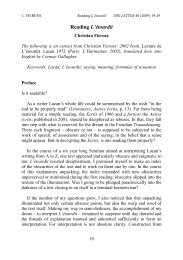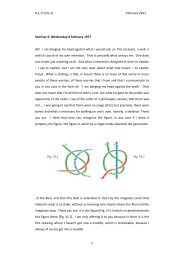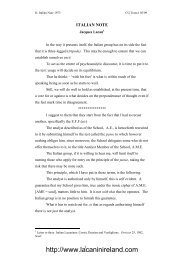I am com<strong>in</strong>g now to the most enigmatic po<strong>in</strong>t of the bus<strong>in</strong>ess, which is that thisposition <strong>in</strong> which the subject f<strong>in</strong>ds itself thunderstruck under the look of the S 2 <strong>in</strong>the real, a thunderstruck position, without speech before this monstrous look, theword monstrous is not here by chance, because it is a matter of the reality whichshows itself (se montre), that this ‘monster’, which is precisely the most radical<strong>in</strong>cognito and that, if this S 2 shows itself, what supports speech itself, namely, itseffac<strong>in</strong>g, can no longer arrive, and if a monster is monstrous, it is noth<strong>in</strong>g otherthan the cutt<strong>in</strong>g of speech.The high po<strong>in</strong>t of the riddle that we are gett<strong>in</strong>g to, is to try to <strong>in</strong>terpret how Bozefbe<strong>in</strong>g <strong>in</strong> B3, if we posit that he is not go<strong>in</strong>g to rema<strong>in</strong> there all his life, <strong>in</strong> eternitylike a petrified subject, fixed <strong>in</strong> stone, under the look of Medusa, what is go<strong>in</strong>g toenable the subject at B3 get out of it? And how is he go<strong>in</strong>g to get out of it?So then the first step that I am pos<strong>in</strong>g, is that you see that at that moment therethere is no longer the support of the messenger; the messenger was at the end ofhis course and at the end of his recourse to Bozef and for the first time Bozef isconfronted to the Other and with this Other, namely, with the one to whom theletter was really addressed and meet<strong>in</strong>g whom he avoided as much as possible, atthat moment he is face to face with this Other and he cannot do anyth<strong>in</strong>g otherthan say a word recognis<strong>in</strong>g this Other, one word and one alone. The importantth<strong>in</strong>g is to see the l<strong>in</strong>k that there is between the fact that he can only say a s<strong>in</strong>gleword, with the fact, at the moment when he gives up on the messenger, namely,the moment at when there are no longer two of them to transmit the message tothe Other. It is also then the moment when the Other is go<strong>in</strong>g to receive amessage that will not come from the two, it will no longer be duplicity, one couldsay that the position of duplicity at that moment, <strong>in</strong>teriorised by Bozef,metamorphises him by divid<strong>in</strong>g him, that is the division and the price of ‘oneword’.You see there moreover that duplicity is without doubt the best defence aga<strong>in</strong>stdivision. The fact that there is a l<strong>in</strong>k between a s<strong>in</strong>gle possible word, Bozef isgo<strong>in</strong>g to be confronted with the k<strong>in</strong>g at R3, there is only one possible word to68
which I will return later, what is the only th<strong>in</strong>g that he can say to him? He will sayto him: ‘It is you’. An ‘it is you’ that is extended moreover – I will come back onthis later, <strong>in</strong>to ‘it is us’. And the s<strong>in</strong>gle word that he can say to him, he says to himat the same time: there is only one person to whom I can say it and it is alreadyfrom topology that we can see that one word can only be given at one locus andthat the tongue itself shows you that it knows this topology s<strong>in</strong>ce it tells you thatsomeone that has speech has only one and cannot have another; someone whohas no speech, precisely has only one and at the same time there is the notion <strong>in</strong>the tongue of the dest<strong>in</strong>ation, s<strong>in</strong>ce, to give his word, is only conceivable if onecan keep it namely, <strong>in</strong> fact a word that can be kept, the po<strong>in</strong>t therefore at which Iarrive, is that the message delivered is this ‘it is you’ and I am go<strong>in</strong>g to write it foryou <strong>in</strong> a way at a certa<strong>in</strong> level, I am go<strong>in</strong>g to write a letter which is go<strong>in</strong>g to gofrom B3 to R3, B3 and R3 are go<strong>in</strong>g to meet at the level of this message which Iwill further explicitate now as be<strong>in</strong>g this S of Ø. I am go<strong>in</strong>g to give you a first wayof writ<strong>in</strong>g it.What I have drawn on the schema on the left is that when Bozef with his back tothe wall this time can only say one word to the k<strong>in</strong>g by the very fact that headdresses this word to the k<strong>in</strong>g, the k<strong>in</strong>g one last time is displaced, migrates,migrates from the place where he was, namely, of the Real, migrates anew <strong>in</strong>tothe locus, <strong>in</strong>to the symbolic locus where there is found <strong>in</strong> the position of R4, Bozefsay<strong>in</strong>g ‘It is you’ who is <strong>in</strong> the position of B4, the S(O), I am writ<strong>in</strong>g of the meet<strong>in</strong>g,of the communion between B4 and R4, both putt<strong>in</strong>g <strong>in</strong> common at that momenttheir bar and that is why I wrote <strong>in</strong> the lunlua S 2 and S(O); I hope to be able toexplicitate more rigorously <strong>in</strong> what is go<strong>in</strong>g to follow.The po<strong>in</strong>t of the enigma on which I would like to keep you, is that, <strong>in</strong> the messagedelivered at S(Ø), <strong>in</strong> the ‘it is you’, is that the subject who keeps his word – as wehave seen – is here <strong>in</strong> a position much more of keep<strong>in</strong>g it, but of support<strong>in</strong>g it,which is someth<strong>in</strong>g quite different. What does it mean to susta<strong>in</strong> a word? It ismuch easier first of all to say what it is not, for example someone who says toyou: ‘I th<strong>in</strong>k that, when <strong>Lacan</strong> says the unconscious is structured like a language, Ith<strong>in</strong>k that he is right, I agree with him’, even if the subject may assure himself ofhis th<strong>in</strong>k<strong>in</strong>g <strong>in</strong> all good faith by th<strong>in</strong>k<strong>in</strong>g that he th<strong>in</strong>ks that the unconscious is69
- Page 1:
Seminar 1: Wednesday 16 November 19
- Page 5 and 6:
after all noticed that to consist m
- Page 7 and 8:
It would be enough for you to take
- Page 9 and 10:
There had therefore been a turning
- Page 11:
Supposing that we have a torus in a
- Page 15 and 16:
topology encourages us to do so. Th
- Page 17 and 18: and me, and I who, in short, by din
- Page 19 and 20: we cut it in two, the front and the
- Page 21 and 22: is itself a hole and in a certain w
- Page 23 and 24: Everyone knows that this is how thi
- Page 25 and 26: Seminar 3: Wednesday 21 December 19
- Page 27 and 28: proceed to this double cut, a doubl
- Page 29 and 30: The inside and the outside in this
- Page 31 and 32: egards the structure of the body, o
- Page 33 and 34: inspired by it and its inspiration,
- Page 35 and 36: music on you, is that it has this p
- Page 37 and 38: from the beloved to the lover. What
- Page 39 and 40: that the little o-object is not uni
- Page 41 and 42: Seminar 4: Wednesday 11 January 197
- Page 43 and 44: short I called the discourses; the
- Page 45 and 46: It is flattened out, and in a way t
- Page 47 and 48: astonishes me still more, is not th
- Page 49 and 50: Seminar 5: Wednesday 18 January 197
- Page 51 and 52: see it here, namely, something that
- Page 53 and 54: namely, that everything that concer
- Page 55 and 56: Let’s see. Let us try to see here
- Page 57 and 58: - X: You can’t hear me because pr
- Page 59 and 60: Seminar 6: Wednesday 8 February 197
- Page 61 and 62: its relationship to the body that w
- Page 63 and 64: that in the position B1, would be t
- Page 65 and 66: is in the position of maintaining t
- Page 67: Effectively the problem of primary
- Page 71 and 72: the object of desire is not unknown
- Page 73 and 74: that he tells the truth. You see th
- Page 75 and 76: look of the Real, there is not, for
- Page 77 and 78: accentuated by him is the search fo
- Page 79 and 80: What is happening, is it not, the d
- Page 81: grounded and articulatable way, and
- Page 84 and 85: eason is said to be purloined, whil
- Page 86 and 87: Borromean knot with that of the Ima
- Page 88 and 89: Alain Didier Weill, for his part, i
- Page 90 and 91: Seminar 8: Wednesday 8 March 1977Wh
- Page 92 and 93: shouldn’t tell you, at 7.15 at Ju
- Page 94 and 95: means that the tongue fails, that,
- Page 96 and 97: of his time as a formidable cleric
- Page 98 and 99: It is very difficult not to waver o
- Page 100 and 101: I remind you that the place of semb
- Page 102 and 103: this term in the feminine, since th
- Page 104 and 105: which coincides with my experience,
- Page 106 and 107: and to put that for you in black an
- Page 108 and 109: see, does not see too great an inco
- Page 110 and 111: that exists, he says what he believ
- Page 112 and 113: In short, one must all the same rai
- Page 114 and 115: particular besides, neurotic, a sex
- Page 116 and 117: functioning as something else. And
- Page 118 and 119:
mean to deny? What can one deny? Th
- Page 120 and 121:
slipping from word to word, and thi
- Page 122 and 123:
Seminar 12: 17 May 1977People in th
- Page 124 and 125:
y writing. And writing only produce
- Page 126 and 127:
not pinpointed it? He calls this a














